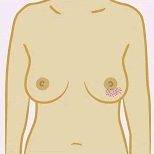Be breast aware
Breast awareness
Breast cancer is the most common cancer in the UK. Breast cancer is not one single disease. There are several types of breast cancer. It can be diagnosed at different stages of development and can grow at different rates. This means that people can be given different treatments, depending on what will work best for them.
Having breast cancer doesn’t necessarily mean that someone is going to die. Better treatments mean that more and more people are now living long and full lives after breast cancer.
Being breast aware
Whatever your age, size or shape, it’s important to take care of your breasts. Being breast aware is about caring for your body. It means getting to know how your breasts look and feel, so you know what is normal for you. Then if you notice a change, you will feel more confident about going to see your GP and getting the change checked out.
How do I check my breasts?
There’s no right or wrong way to check your breasts. Try to get used to looking at and feeling your breasts regularly. You can do this in the bath or shower, when you use body lotion, or when you get dressed. There’s really no need to change your everyday routine. Just decide what you are comfortable with and what suits you best. Remember to check all parts of your breast, your armpits and up to your collarbone.
The breast awareness 5-point code:
1. Know what is normal for you
2. Know what changes to look and feel for
3. Look and feel
4. Report any changes to your GP without delay
5. Attend routine breast screening if you are aged 50 or over
Department of Health 2009
Changes to look and feel for
To pick up potential problems at the earliest possible opportunity, you need to be aware of any changes in your breasts, which you can see in the images below.

A change in size or shape

Redness or a rash on the skin on/or around the nipple

Discharge (liquid) from one or both of your nipples

A swelling in your armpit or around your collarbone

A lump or tickening that feels different from the rest of the breast tissue

A change in skin texture such as puckering or dimpling (like orange skin)

If your nipple becomes inverted (pulled in) or changes its position or shape

Constant pain in your breast or your armpit
It is important to remember that these changes are not usually accompanied with any other symptoms such as tiredness or loss of energy.
What to do next
If you notice a change, please see your GP straight away. Your GP may be able to reassure you after examining your breasts, or you may be asked to come back at a different time in your menstrual cycle to rule out a hormonal cause. Alternatively, you may be sent to a breast clinic for a more detailed examination.
For more information visit
Breast Cancer Now's website or call Breast Cancer Now’s free, confidential Helpline on
0808 800 6000.
Information provided by Breast Cancer Care. June 2011. (Charity now known as Breast Cancer Now)
Registered charity in England and Wales (1160558) Registered charity in Scotland (SC045584)